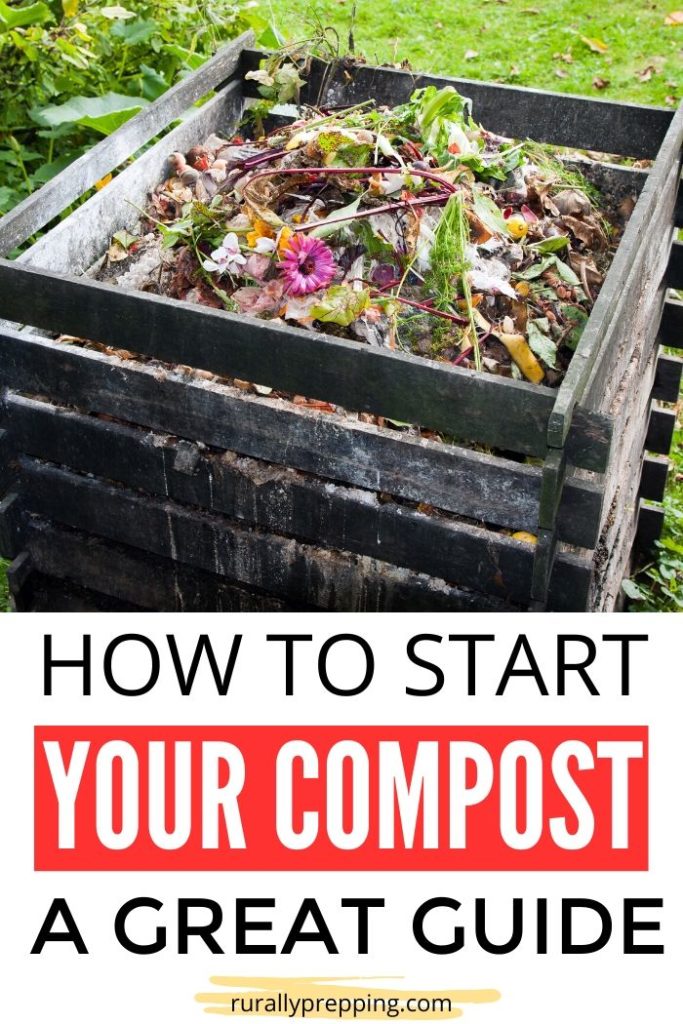In need of a Beginner’s Guide on How to Compost? You are definitely not alone. Many people have heard of composting, they know what compost does, but they just don’t think they have the time to do it.

They think it is labor intensive, or just doesn’t make much of a difference to their plants, and so they push it to the back burner and swear they will give it a try next year. Well if you are one of those people who keep putting composting off, now is the time to realize its value and get serious!
Related: Vegetables to Grow in a Canning Garden
Look below at this beginner’s guide to composting and see how easy it can be, how beneficial it can be to your plants, and how helpful it can be to your budget. Let’s get started
What to use as a compost bin
First, let’s talk about what you need to store your compost in. Most people call this a compost bin. You don’t need anything fancy, even a trash can with drainage holes or a storage tote with a lid and drainage holes will work. You basically want a roomy container that you can cover securely to keep animals out. As mentioned, some containers include:
- trash can
- plastic storage tote
- store bought compost bin
- even a large mixing bowl on your countertop will work
Related: Pallet Garden
Remember, a proper lid on your bin can keep out critters who would love to munch on the scraps.
If you want to start small, try keeping a mixing bowl on the counter to save food scraps. You can use an old ice cream pail and transfer it outside to your bigger bin when it’s full.
What can be added to a compost bin
Once you have your bin, you are ready to start collecting the materials to create your compost. You can compost all sorts of kitchen and household scraps! Start saving kitchen and household items such as:
- eggshells
- coffee grounds
- coffee filters
- stale bread
- citrus peels
- apple cores
- banana peels
- vegetable and fruit peels and rinds
- paper scraps (junk mail comes in handy here)
These items when added to your compost bin will break down into nutrient rich soil for your plants. However, there are items you should NEVER add to your compost bin.
What not to add to your compost bin
Never add meat or dairy products as these will not break down properly and can ruin your compost.
How does composting work
So, how does the composting work? Let’s chat about that. Little by little you will add the scraps to your composting bin. Continue adding until the bin is full.
Every few days, take a yardstick or shovel and stir the mixture. This will help add some air to the mixture so that it continues to break down properly. You will be amazed how quickly these materials start to break down and a rich substance is formed.
After a few weeks, you will have what gardeners call black gold. This nutrient rich mixture is like gold to your plants. Learn more about the benefits of composting.
When do you start using compost
As soon as your compost is broken down you can start using it. It is ideal to start composting now, even though there is still a chill in the air. This way by planting season you will have some compost ready to go. Continue to compost during the summer months so you can have plenty of compost on hand during the fall gardening months.
How to use compost
You can use your compost by turning it into your topsoil prior to planting, or using it at the base of the plants like fertilizer after you plant. You can’t over compost, so feel free to add your black gold as often as you wish.
Related: Plants for Your Salad Garden
You can also use your compost on your fruit and vegetable plants or even add it to your flower pots. You will find it to be one of the best plant foods, and the best part is you can create it for FREE!
Learning how to compost can be fun, easy, and budget friendly. When you compost you are using scraps you would otherwise toss, so it is a great way to reduce waste and instead put it to use. So, consider creating your own compost bin and starting your own compost now.